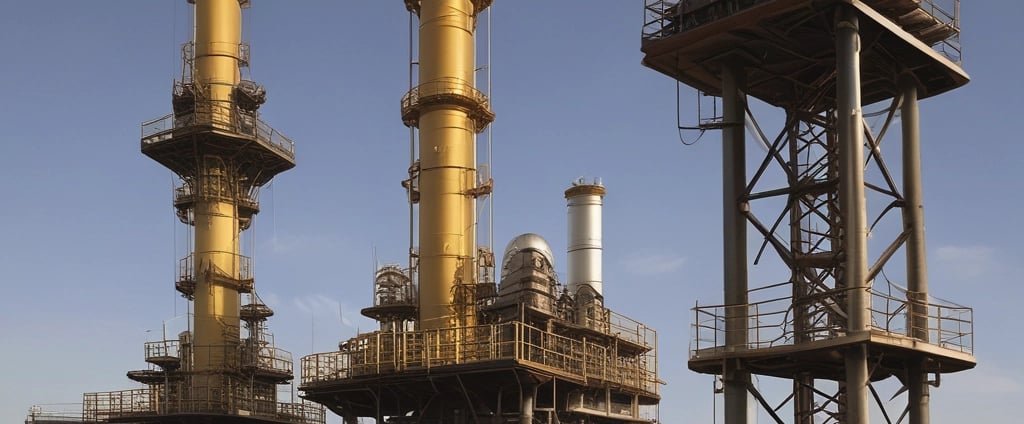Emerging Trends in Oil & Gas Engineering
Blog post descriThe oil and gas industry is undergoing a significant transformation, driven by technological advancements and the need for sustainability. From digital twins and AI-driven analytics to the integration of renewable energy sources, engineering solutions are adapting to meet new challenges. This blog explores key trends, such as automation in upstream operations, carbon capture technologies, and the shift toward greener production processes. It highlights how staying ahead of these trends can offer a competitive edge in the rapidly evolving energy sector.ption.
Sachin N
5/24/20233 min read


Emerging Trends in Oil & Gas Engineering
The oil and gas industry, long considered the backbone of the global energy sector, is undergoing a significant transformation. As technological advancements, environmental concerns, and shifting economic dynamics converge, new trends are shaping the future of oil and gas engineering. These developments promise to redefine how energy is produced, processed, and delivered while addressing the challenges of sustainability and efficiency. Below, we explore some of the most prominent emerging trends in oil and gas engineering.
1. Digital Transformation and Industry 4.0
Digitalization is revolutionizing the oil and gas sector, enabling smarter, faster, and safer operations. Key components of this transformation include:
- Artificial Intelligence (AI) and Machine Learning (ML): AI and ML algorithms analyze massive datasets to optimize exploration, drilling, and production processes. Predictive maintenance powered by ML helps reduce equipment downtime and improve operational efficiency.
- Internet of Things (IoT): IoT devices, such as sensors and actuators, provide real-time data on equipment performance, environmental conditions, and production metrics. This data enhances decision-making and reduces operational risks.
- Digital Twins: These virtual replicas of physical assets enable engineers to simulate, monitor, and optimize performance without disrupting operations. Digital twins are increasingly used for designing and managing complex facilities like refineries and offshore platforms.
2. Automation and Robotics
Automation is playing a pivotal role in minimizing human intervention in hazardous environments and improving operational efficiency. Recent innovations include:
- Robotic Drilling Systems: Fully automated rigs enhance precision and reduce the time required for drilling operations.
- Inspection Robots: Autonomous drones and robots inspect pipelines, rigs, and other infrastructure to detect anomalies and prevent accidents.
- Subsea Robots: Remotely Operated Vehicles (ROVs) and Autonomous Underwater Vehicles (AUVs) perform underwater tasks, such as equipment installation and maintenance, with minimal human involvement.
3. Sustainable Practices and Green Engineering
The industry is under increasing pressure to adopt sustainable practices. Oil and gas engineering is aligning with environmental goals through:
- Carbon Capture, Utilization, and Storage (CCUS): Technologies that capture CO2 emissions and either store them underground or repurpose them for industrial use are gaining traction.
- Energy Efficiency: Engineers are developing more efficient processes to reduce energy consumption during extraction, refining, and transportation.
- Renewable Integration: Hybrid projects combining oil and gas with renewable energy sources, such as solar or wind, are emerging as part of the industry’s transition to cleaner energy.
4. Advanced Materials and Nanotechnology
Innovative materials and nanotechnology are transforming equipment design and performance in the sector. For example:
- Smart Coatings: These materials protect pipelines and infrastructure from corrosion, extending their operational lifespan.
- Nanomaterials: Advanced nanoparticles enhance oil recovery by improving the mobility and extraction of hydrocarbons from reservoirs.
5. Enhanced Oil Recovery (EOR) Techniques
As conventional oil reserves decline, EOR methods are becoming essential. New advancements include:
- Chemical EOR: The use of specialized chemicals, such as polymers and surfactants, to increase oil recovery from mature fields.
- Thermal EOR: Innovations in steam injection and other thermal techniques are making it easier to extract heavy crude.
- Microbial EOR: Leveraging microbes to alter reservoir conditions and improve hydrocarbon recovery is gaining interest due to its environmental benefits.
6. Data Analytics and Cloud Computing
The integration of big data analytics and cloud-based systems has enhanced data management and collaboration. Key applications include:
- Reservoir Simulation: Advanced analytics improve reservoir modeling, leading to more accurate predictions of oil and gas reserves.
- Supply Chain Optimization: Cloud-based platforms streamline logistics, inventory, and procurement, reducing costs and delays.
7. Decommissioning and Asset Lifecycle Management
As oilfields and facilities reach the end of their operational lives, decommissioning is becoming a critical focus area. Engineers are employing innovative techniques to:
- Safely dismantle and repurpose offshore platforms.
- Recycle and reuse materials to minimize environmental impact.
- Develop frameworks for managing assets throughout their lifecycle, from design to decommissioning.
8. Hydrogen as a Transition Fuel
Hydrogen is gaining attention as a bridge fuel in the transition to a low-carbon economy. The oil and gas sector is investing in:
- Blue Hydrogen: Produced from natural gas with carbon capture to reduce emissions.
- Green Hydrogen: Created using renewable energy, it offers a sustainable alternative to fossil fuels.
9. Resilience and Risk Management
Extreme weather events, geopolitical instability, and cybersecurity threats necessitate robust risk management strategies. Engineers are incorporating:
- Climate-Resilient Designs: Infrastructure capable of withstanding extreme environmental conditions.
- Cybersecurity Measures: Advanced systems to protect critical data and operations from cyberattacks.
Conclusion
The oil and gas industry is at a crossroads, balancing the need for traditional energy production with the demands of a sustainable future. Emerging trends in digitalization, automation, sustainability, and advanced materials are reshaping the field of oil and gas engineering. By embracing these innovations, the industry can address its challenges while seizing opportunities for growth and efficiency in a rapidly evolving energy landscape.


